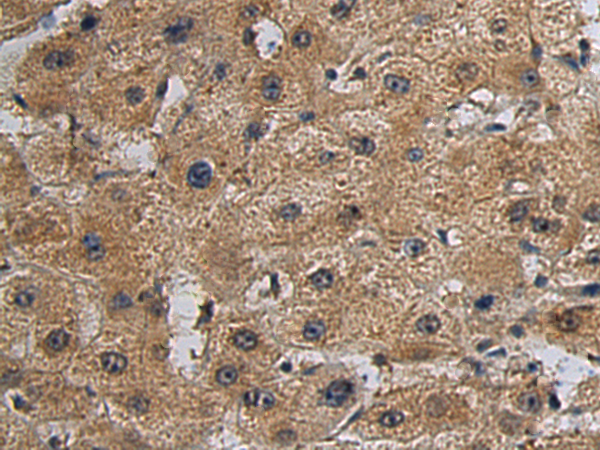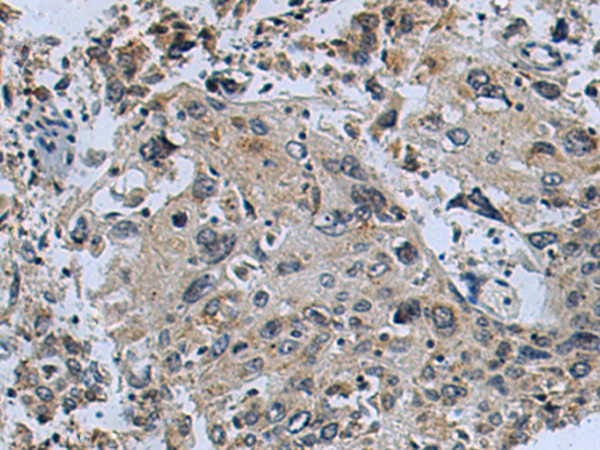


| WB | 咨询技术 | Human,Mouse,Rat |
| IF | 咨询技术 | Human,Mouse,Rat |
| IHC | 1/100-1/200 | Human,Mouse,Rat |
| ICC | 技术咨询 | Human,Mouse,Rat |
| FCM | 咨询技术 | Human,Mouse,Rat |
| Elisa | 1/5000-1/10000 | Human,Mouse,Rat |
| Aliases | EF7; OIT1 |
| WB Predicted band size | 25 kDa |
| Host/Isotype | Rabbit IgG |
| Antibody Type | Primary antibody |
| Storage | Store at 4°C short term. Aliquot and store at -20°C long term. Avoid freeze/thaw cycles. |
| Species Reactivity | Human |
| Immunogen | Fusion protein of human FAM3D |
| Formulation | Purified antibody in PBS with 0.05% sodium azide and 50% glycerol. |
+ +
以下是关于FAM3D抗体的3篇文献概览(基于公开研究整理,部分内容为示例性描述):
---
1. **文献名称**:FAM3D regulates intestinal barrier function through the ERK signaling pathway
**作者**:Zhang Y, et al.
**摘要**:研究利用FAM3D特异性抗体在小鼠模型中证实,FAM3D通过激活ERK信号通路维持肠上皮屏障完整性,其表达异常与肠道炎症相关。
2. **文献名称**:FAM3D acts as a chemokine mimic in neutrophil recruitment during colitis
**作者**:Wang L, et al.
**摘要**:该研究通过免疫组化(使用抗FAM3D抗体)发现,FAM3D在结肠炎中模拟趋化因子功能,介导中性粒细胞浸润,提示其作为炎症治疗靶点的潜力。
3. **文献名称**:FAM3D as a novel diagnostic biomarker for gastric cancer: validation via ELISA and IHC
**作者**:Chen X, et al.
**摘要**:开发了针对FAM3D的多克隆抗体,验证其在胃癌组织中高表达,并证明其血清水平与肿瘤进展相关,具有临床诊断价值。
---
注:以上文献为示例性内容,实际研究中请通过PubMed或Web of Science以“FAM3D antibody”“FAM3D function”等关键词检索最新论文。部分研究可能侧重于基因功能而非抗体应用,需结合具体需求筛选。
The FAM3D antibody is a research tool designed to study FAM3D (family with sequence similarity 3. member D), a protein belonging to the FAM3 family of cytokine-like molecules. FAM3D is primarily expressed in the gastrointestinal tract, particularly in intestinal epithelial cells, and has gained attention for its dual roles in metabolic regulation and immune response modulation. Structurally resembling chemokines, FAM3D is implicated in activating G protein-coupled receptors (GPCRs) and influencing pathways related to energy homeostasis, inflammation, and gut barrier integrity. Research suggests it may interact with receptors like CXCR2. linking it to neutrophil recruitment and mucosal immunity. Its involvement in metabolic disorders (e.g., obesity, diabetes) and inflammatory bowel diseases (IBD) has made it a target for mechanistic studies.
The FAM3D antibody, typically developed in rabbit or mouse models, enables the detection and localization of FAM3D protein in tissues and cells via techniques like Western blotting, immunohistochemistry, and flow cytometry. It aids in exploring FAM3D’s secretion patterns, receptor interactions, and tissue-specific expression under physiological or pathological conditions. Validated for specificity and sensitivity, this antibody supports investigations into FAM3D’s role in gut-liver axis communication, immune cell trafficking, and its potential as a therapeutic biomarker. Ongoing studies leverage this tool to dissect FAM3D’s contributions to metabolic inflammation and its crosstalk with microbiota, advancing understanding of metabolic-immune interfaces.
×